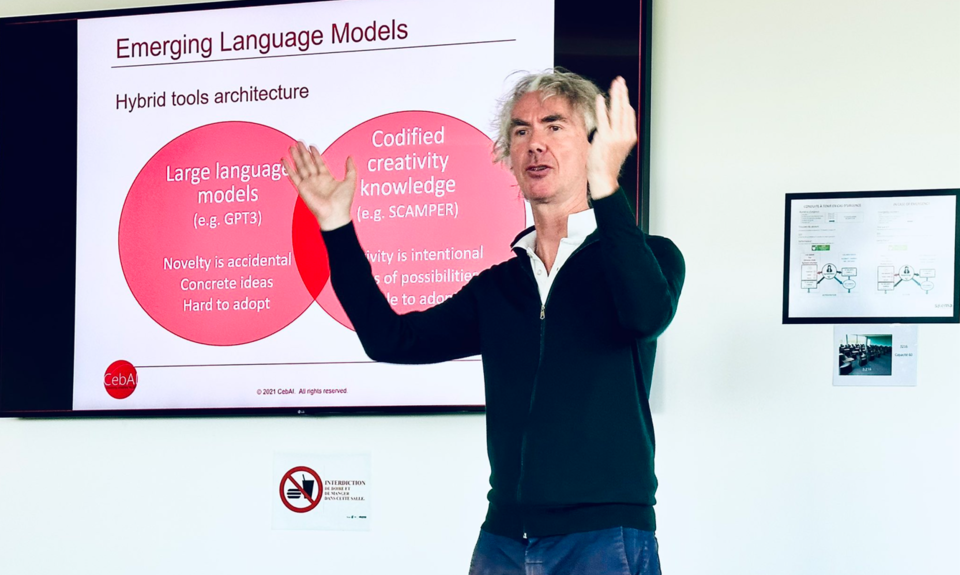Is there any border between business, Artifical Intelligence (AI) and creativity? Neil Maden (Director, National Centre for Creativity enabled by AI, Bayes Business School) tries to link them all together. As the guest of the thought-provoking seminar by SKEMA Center for AI, he answered Margherita Pagani’s questions. According to the Professor of Digital Creativity, AI is a source of creativity in the workplace, not the opposite.
As a researcher, why investigate AI and creativity for business?
I’m fascinated by creativity. I’m a computer scientist, and I became interested in how we design computer systems. It became quite clear after a time that nobody taught me as a software engineer that creativity was part of this process. I always remember an example when I would set my students the task of designing a new ATM system where you get money from a machine. And their first reaction after the class was to run outside to the bank next door and watch how people used it in order to replicate it. It wasn’t in their mindset to be creative. There’s a large body of work that suggests the education systems make us less creative. I wanted to understand how we could introduce creative thinking into design, it was a missing piece. And through that investigation, I realized that creativity could be deployed in many aspects of our lives, working and personal lives, that we don’t exploit it, we don’t recognize its need. I’ve always thought that I’m reasonably creative, perhaps not in an artistic sense, but I do like to come up with new ways of solving things. As a software engineer, I see a very strong opportunity to deploy AI tools to augment and support people’s creative thinking rather than automate it.
But ironically, to develop AI tools that enables us to be more creative could make us less creative…
Yes, I think one of the risks that we see with the new generation of large language models is that if we can automate it, we will. At the moment, if you take ChatGPT, you could type in a business challenge, and it will come out with a sort of business plan for you. But it’s still quite crude. There will be agents running different GPT or large language model analyses in order to generate different parts of a strategy that it composes together. All of this can be automated. There’s a tendency by technology companies to automate without thinking too much about the user. At the moment, these technology companies are creating global laboratories to test the new automations. And there’s a huge amount of evidence that this automation will not necessarily support human creativity. In fact, it can risk making us lazy. If you look at automation in airplanes, how do you stop the pilots or the air traffic controllers from becoming deskilled? So, we need to design to augment and support this creative thinking. And I think business is one of the application areas in which that can be done.
Read also: Pr. Jerry Wind: “AI offers the opportunity to challenge the educational paradigm”
How do you explain this lack of creativity in business?
I believe there’s an absence of explicit support for creative thinking about business models and strategies. I teach on an MBA programme, and I’m always surprised how a few of the students come in with a predilection to be creative, to do design, thinking about uses of creativity and design in their businesses. It’s not what they’re taught and it’s not what they’ve experienced out there. In fact, there is often an aversion to the words “creative” and “creativity” in business. Somehow this is still associated with artistic endeavors, and it’s a lot to do with aesthetics. We certainly in Europe are facing crises of productivity and innovation. Other parts of the globe are demonstrating that they have other ways of being more productive and innovative. Enhancing creativity and improving creativity skills seem to me absolutely core to the sort of next generation of European economies. There’s a strategic need for this. So, we need to be strategic about creative thinking. Thinking from people working on the shop floor right up to boardrooms. Everybody needs to have more creative thinking skills to improve efficiency, productivity, and through them, innovation.
What are the main barriers to creativity and AI in business?
Well, there’s more than one. The first problem is the sort of lack of technological know-how. Clearly, ChatGPT has, for the first time, exposed a reliable AI technology that’s moving towards artificial general intelligence. But there’s a big difference between playing around with ChatGPT to explore how you can rephrase a poem and applying it reliably to a business context, regularly. Most business people currently lack the technological know-how to manipulate these algorithms.
Secondly, there’s always the risk that people going to businesses are going to take what’s sold to them. And it’s clearly in the interest of these large AI development companies to sell their solutions. That’s not necessarily good for businesses generally. We need a new dialogue to understand what the business needs and what these technologies can provide. We need a design process that prompts co-creation in the large. I don’t think that’s happening, in any real sense, at the moment. If you look at what’s happening with ChatGPT and the APIs that people are currently using, they’re building very simple web-enabled tools and mobile phone apps to undertake relatively simple functions. Do I think that these businesses are engaged in the co-design of these products? Probably not. Instead, I think there’s a mad rush for market share based on what the GPT tools can do.
There is also an interesting issue about knowledge representation. Most current generative AI technologies do not enable a business to define the facts about its worlds. They cannot define their constraints or their strategies. Businesses need to be able to upload their knowledge or interoperate their knowledge with these engines. Alas, I think that the tools or platforms to do that are still some way off.
Another barrier could be around resources. How to deal with the new generations of AI tools is going to become a burden for many organizations who are already working hard post-pandemic to improve their productivity levels, recapture markets, etc. And some of these markets are moving quickly, so it’s not as if they enter this period with resources to spare. Dealing with these new AI technologies might not be a high priority for many businesses. It’s just not on their to-do list. Therefore, we must find ways to communicate how AI can support their everyday strategic and operational activities more effectively. It’s not saying you need to be more creative, it’s simply saying “Is there a new or better way that you could do this via this particular AI service that’s available?”.
How to generate the impact? How to put this in the hands of businesses on a large scale?
We need multiple strategies. I believe there’s a broader problem with how we, in academia, translate our knowledge about AI and creativity to make it available to businesses. This seems to happen more effectively in North America than in Europe. We need to challenge the ways in which we think. Within our CebAI Centre, we’re looking at a range of models. We’ve already explored the University spin-out route. There has been some success, but it’s quite hard to find the resources to build a new business yourself, as well as run other academic activities. We’ve also explored the licensing route, and so we are increasingly licensing our different pieces of software to businesses. To enable this one of the strategic decisions that we undertook was to build a set of software services that had well-defined inputs and outputs and APIs. E.g., if you interact with a tool like Design Sparks, it looks like one tool, but it’s actually really a stack of different software services. We can offer each or combinations of these services to businesses. For example, if we want to work with an agency, the agency could plug these services into its own platform with different licensing agreements. And then we’re also beginning to experiment with venture creation. We’re starting to talk with venture capitalists who can see the value in this and are drilling down on where the very specific value opportunities exist within businesses for creativity. Because one of the big challenges is that at the surface at least, creativity is still seen as a nice tool, not a must-have. It’s a vitamin, not a pill. Therefore, we have to find places and activities in the business where creativity becomes more of a pill rather than a vitamin. This is very much the remit of venture capital work and so we’re working with them and if this is successful, we will license our technologies for them to drill down with. Therefore, we’re adopting a multi-approach strategy. A process of seeing what works, finding out where the spaces are, and partnering with as many people as we can. It’s all about partnerships, talking, and collaboration.






